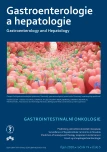Prevalence of hypovitaminosis D and impaired glucose tolerance in patients with neuroendocrine tumours undergoing somatostatin analogues therapy
Authors:
L. Nosáková 1
; P. Bánovčin Jr. 1
; Pindura M. 2; Uhrík P. 1; Hyrdel R. 1
Authors‘ workplace:
Interná klinika gastroenterologická JLF UK a UN Martin, Slovenská republika 2 Chirurgická klinika a transplantačné centrum JLF UK a UN Martin, Slovenská republika
1
Published in:
Gastroent Hepatol 2020; 74(5): 410-414
Category:
Overview
Introduction: Neuroendocrine tumors of the gastrointestinal tract (GEP-NETs) are rare tumors representing a heterogeneous group of tumors. Somatostatin analogs (SSA) are commonly used in the palliative treatment of GEP-NETs. The aim of the study was to determine the potential side effects of SSA treatment. Methods and group of patients: The set consisted of patients undergoing the treatment with somatostatin analogues in an outpatient form. We evaluated the data about disease duration, SSA treatment, and type of SSA preparation. Subsequently, patients underwent vitamin D and blood glucose tests. Results: We evaluated a total of 16 patients (8 women and 8 men). The mean age was 61 years (43–82 years). Hypovitaminosis D was present in 13 patients (81.25%). Vitamin D levels ranged from 12.2 to 55.8 ng/ml. Glucose tolerance impairment was present in 44% of patients. Blood glucose ranged from 4.5 mmol/l to 7.6 mmol/l. Conclusion: Somatostatin analogues are generally considered as safe and well tolerated. In our work, we pointed to the relatively high prevalence of hypovitaminosis D and impaired fasting glucose.
Keywords:
neuroendocrine tumors – somatostatin analogues – hypovitaminosis D – glycemia
Sources
1. Kloppel G, Perren A, Heitz PU et al. The gastroenteropancreatic neuroendocrine cell system and its tumors: the WHO classification. Ann N Y Acad Sci 2004; 1014 : 13–27. doi: 10.1196/annals.1294.002.
2. Hyrdel R. Endokrinné nádory tráviaceho traktu. In: Hrnčiar J et al. Endokrinné a hormonálno-metabolické choroby: ich racionálna diagnostika a komplexná liečba. Banská Bystrica: CentroMedian 2000 : 171–194.
3. Yao JC, Hassan M, Phan A et al. One hundred years after “carcinoid” epidemiology of and prognostic factors for neuroendocrine tumors in 35,825 cases in the United States. J Clin Oncol 2008; 26 (18): 3063–3072. doi: 10.1200/JCO.2007.15.4377.
4. Lamberts SW, Krenning E, Reubi JC. The role of somatostatin and its analogs in the diagnosis and tretamnet of tumors. Endocr Rev 1991; 12 (4): 450–482. doi: 10.1210/edrv-12-4-450.
5. Oberg K. Somatostatin analog octreotide LAR in gastro-entero-pancreatic tumors. Expert Rev Anticancer Ther 2009; 9 (5): 557–566. doi: 10.1586/era.09.26.
6. Öberg K, Ferone D, Kaltsas G et al. ENETS consensus guidelines for the standards of care in neuroendocrine tumors: biotherapy. Neuroendocrinology 2009; 90 (2): 209–213. doi: 10.1159/000183751.
7. Caplin ME, Pavel M, Ćwikła JB et al. Anti-tumour effects of lanreotide for pancreatic and intestinal neuroendocrine tumours: the CLARINET open-label extension study. Endocr Relat Cancer 2016; 23 (3): 191–199. doi: 10.1530/ERC-15-0490.
8. Kulke MH. Somatostatin analogues in neuroendocrine tumors. J Natl Compr Canc Netw 2016; 14 (3): 241–242. doi: 10.6004/jnccn.2016.0029.
9. Modlin IM, Pavel M, Kidd M et al. Review article: somatostatin analogues in the treatment of the gastroenteropancreatic neuroendocrine (carcinoid) tumours. Aliment Pharmacol Ther 2010; 31 (2): 169–188. doi: 10.1111/j.1365 - 2036.2009.04174.x.
10. Massironi S, Conte D, Rossi RE. Somatostatin analogues in functioning gastroenteropancreatic neuroendocrine tumours: literature review, clinical recommendations and schedules. Scand J Gastroenterol 2015; 51 (1): 513–523. doi: 10.3109/00365521.2015.1115117.
11. Rinke A, Müller HH, Schade-Brittinger C et al. Placebo-controlled, double-blind, prospective, randomized study on the effect of octreotide LAR in the control of tumor growth in patients with metastatic neuroendocrine midgut tumors: a report from the PROMID Study Group. J Clin Oncol 2009; 27 (28): 4656–4663. doi: 10.1200/JCO.2009.22.8510.
12. Rubin J, Ajani J, Schirmer W et al. Octreotide acetate long-acting formulation versus open-label subcutaneous octreotide acetate in malignant carcinoid syndrome. J Clin Oncol 1999; 17 (2): 600–606. doi: 10.1200/JCO.1999.17. 2.600.
13. Basuroy R, Bouvier C, Ramage JK et al. Delays and routes to diagnosis of neuroendocrine tumours. BMC Cancer 2018; 18 (1): 1122. doi: 10.1186/s12885-018-5057-3.
14. Basuroy R, Bouvier C, Ramage JK et al. Presenting symptoms and delay in diagnosis of gastrointestinal and pancreatic neuroendocrine tumours. Neuroendocrinology 2018; 107 (1): 42–49. doi: 10.1159/000488510.
15. Fiebrich HB, van den Berg G, Kema IP et al. Deficiencies in fat-soluble vitamins in long-term users of somatostatin analogue. Aliment Pharmacol Ther 2010; 32 (11–12): 1398–1404. doi: 10.1111/j.1365-2036.2010.044 79.x.
16. Grasso LF, Auriemma RS, Pivonello R et al. Adverse events associated with somatostatin analogs in acromegaly. Expert Opin Drug Saf 2015; 14 (8): 121–126. doi: 10.1517/14740338.2 015.1059817.
17. O’Toole D, Ducreux M, Bommelaer G et al. Treatment of carcinoid syndrome: a prospective crossover evaluation of lanreotide versus octreotide in terms of efficacy, patient acceptability, and tolerance. Cancer 2000; 88 (4): 770–776. doi: 10.1002/ (sici) 1097-0142 (20000215) 88 : 4<770:: aid-cncr6>3.0.co; 2-0.
Labels
Paediatric gastroenterology Gastroenterology and hepatology SurgeryArticle was published in
Gastroenterology and Hepatology

- Metamizole at a Glance and in Practice – Effective Non-Opioid Analgesic for All Ages
- Possibilities of Using Metamizole in the Treatment of Acute Primary Headaches
- Metamizole in perioperative treatment in children under 14 years – results of a questionnaire survey from practice
- The Importance of Limosilactobacillus reuteri in Administration to Diabetics with Gingivitis
Most read in this issue
- Budesonide in the treatment of idiopathic intestinal infl ammation
- Proton pump inhibitors – do we know them well and are they really that safe? – part 1
- New member of the editorial board MUDr. Kristýna Zárubová
- Predictors of advanced colorectal neoplasia in colorectal cancer screening – interim results of multicentric prospective study
